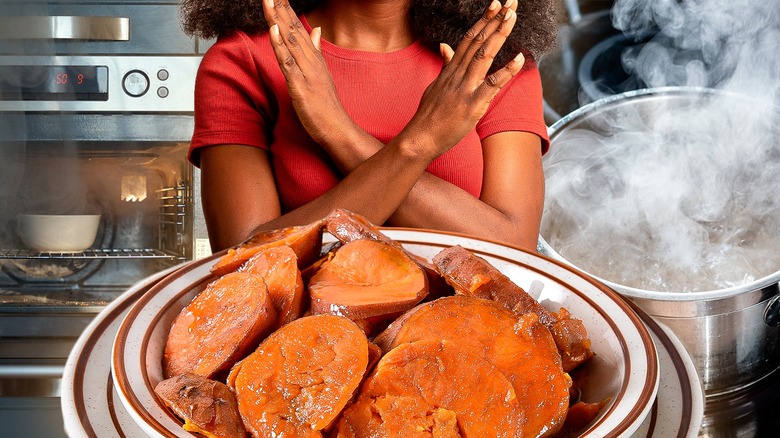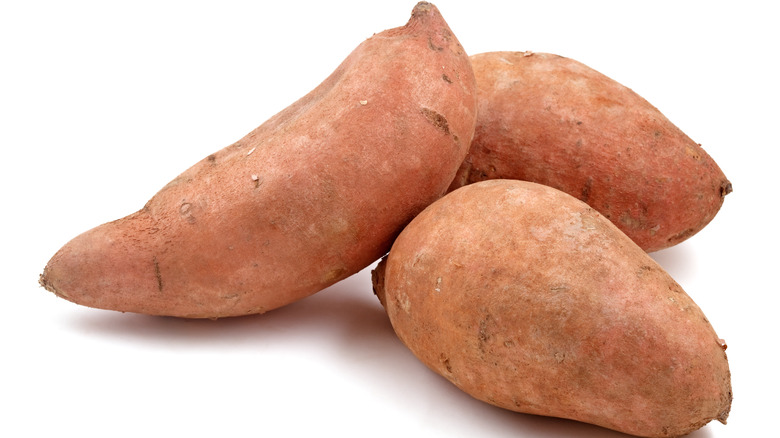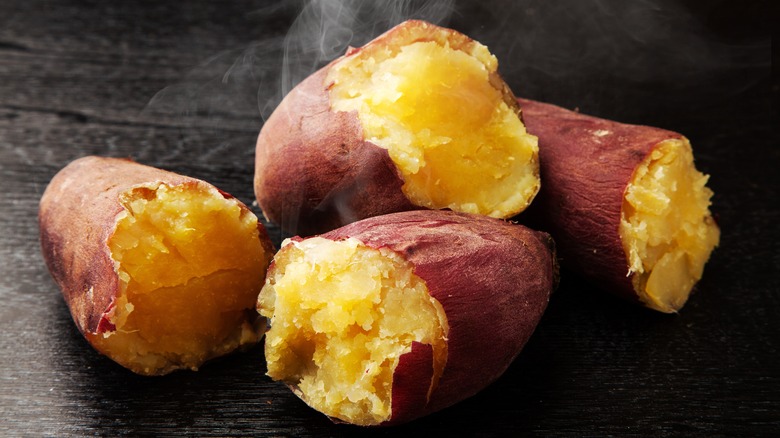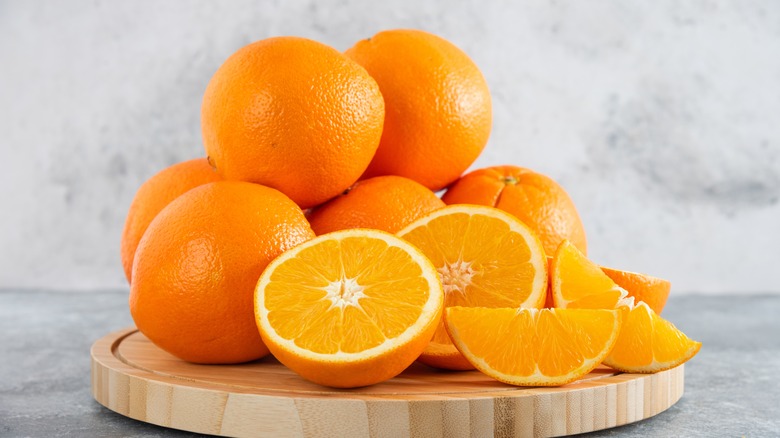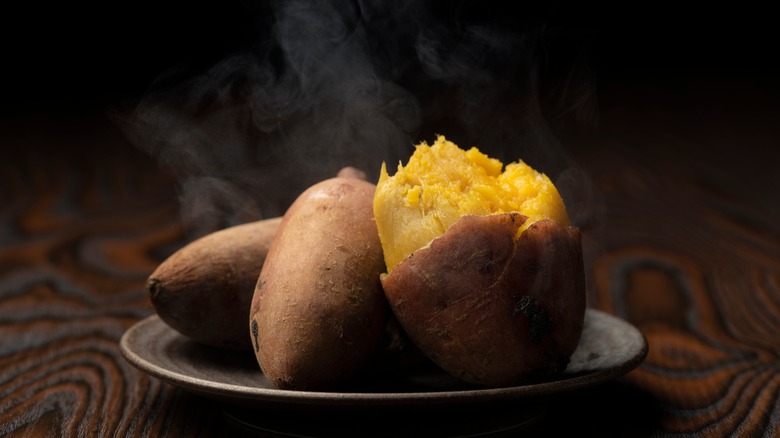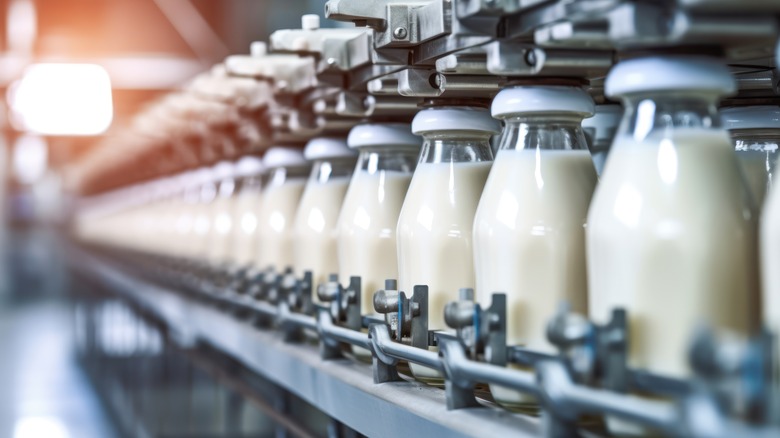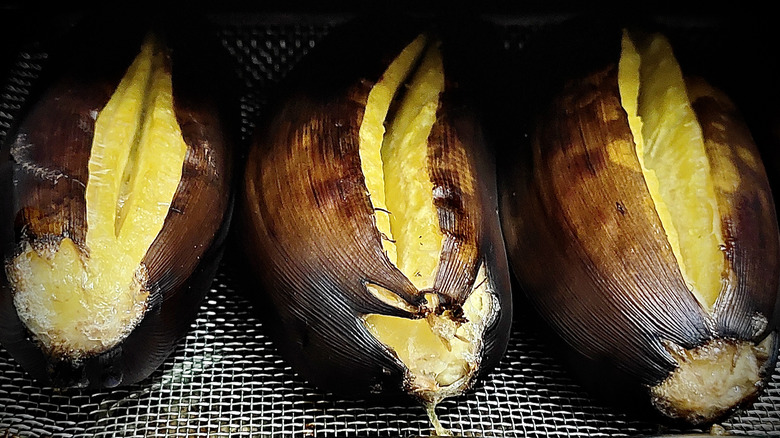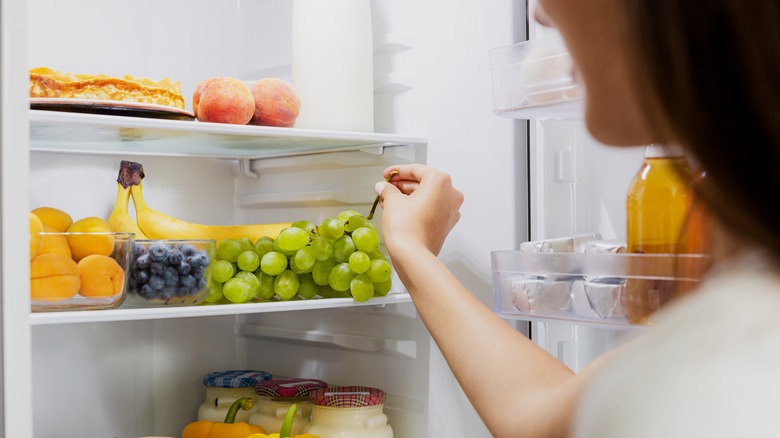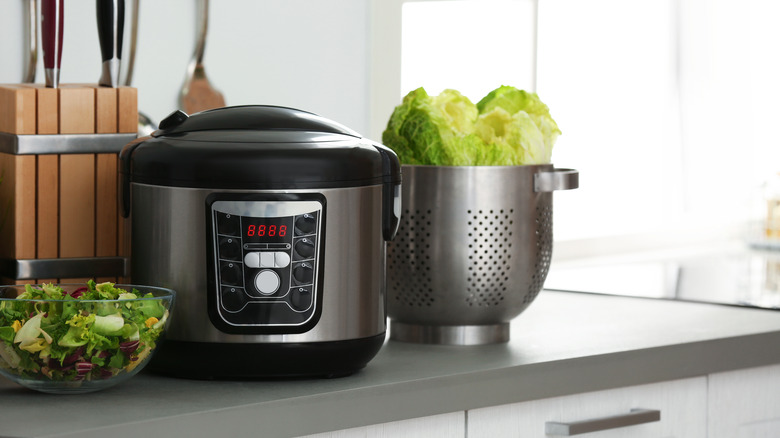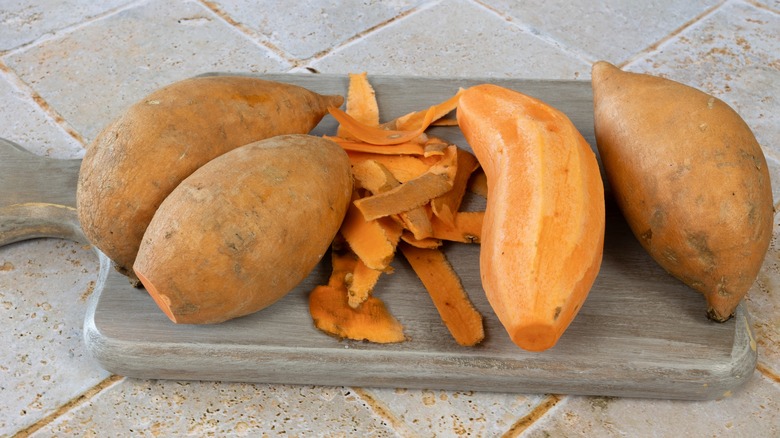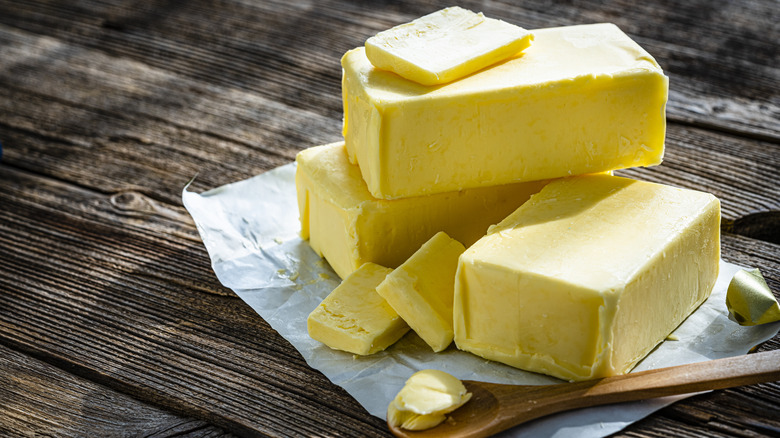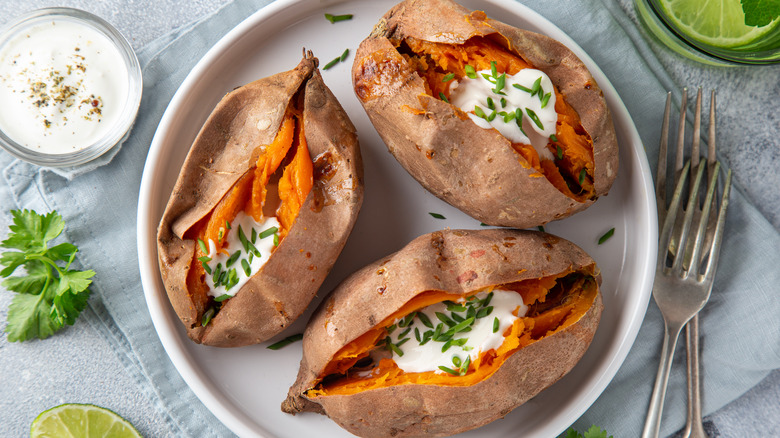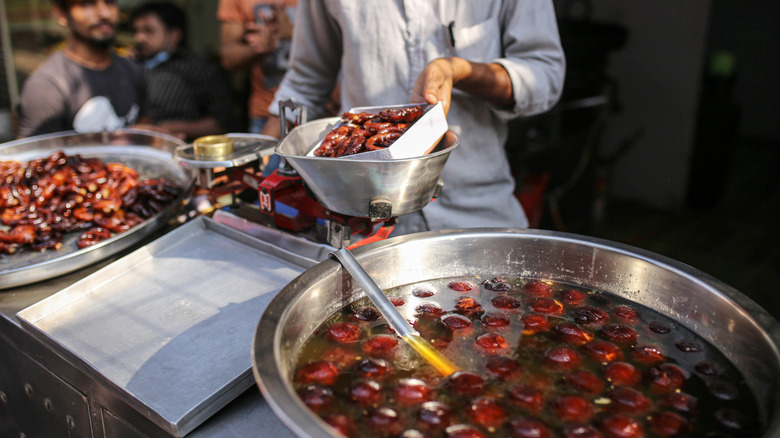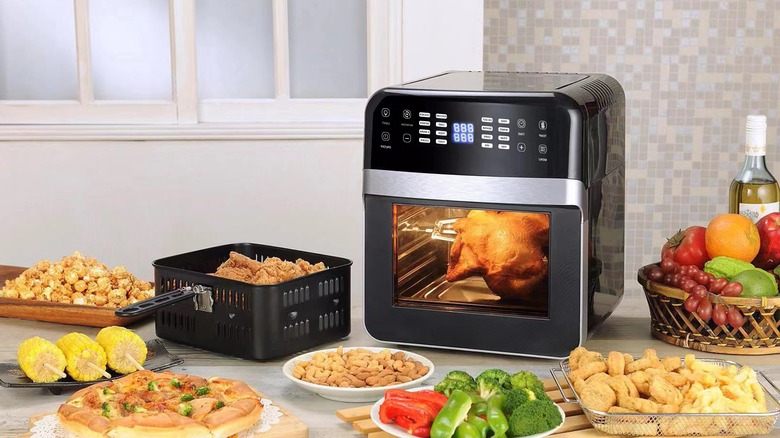13 Mistakes Everyone Makes When Cooking With Sweet Potatoes
Sweet potatoes, with their vibrant orange hue and rich, sweet flavor, are ideal for warm and comforting dishes. These nutritional powerhouses are packed with vitamins, minerals, and fiber. Many easy and enduring dishes can be made with this root vegetable, including the much-beloved sweet potato casserole.
But despite their enduring popularity, sweet potatoes can sometimes be a challenge for some home cooks. For one, they have a dense and firm texture, which is great when they're prepared correctly, but that can make for a tricky cooking experience. Meanwhile, unlike their regular potato counterparts, sweet potatoes are starchier and have a higher sugar content. This unique composition poses difficulties in achieving the desired tenderness without sacrificing flavor or ending up with a mushy consistency.
Another layer of complexity to cooking with them involves the types of sweet potatoes. The two main varieties, often labeled as "firm" and "soft," differ not only in texture but also in their recommended cooking methods. Choosing the wrong type for a particular dish can result in disappointment, making it imperative for cooks to discern between the two. Additionally, the caramelization of sweet potatoes during cooking can lead to uneven browning, leaving some parts overly sweet while others lack flavor. Balancing this sweetness becomes crucial, requiring a delicate touch and precise culinary skills. So let's take a look at some of the most common pitfalls of cooking with sweet potatoes and how to address them.
Buying the wrong sweet potatoes
Sweet potatoes may look indestructible, but just like with any other produce item, they can go bad. The problem is that since the outer layer of a sweet potato is brown, as are typical blemishes, spotting a sweet potato that is past its prime can be a bit tricky. Indeed, many people make the mistake of grabbing any old sweet potato off the supermarket shelves and bringing it home, only to find deep flaws in the product upon closer inspection.
The solution is simple: Apply that closer inspection when you're still in the store. Spotting bruises is pretty easy with certain fruits or vegetables, such as peaches or peppers, but with sweet potatoes, it can require a little extra prodding to feel out those soft spots. That said, you should be able to see any protruding sprouts right away, and those are a surefire sign that the potato has seen better days. You can always try to cut off the bad parts if you really must, but to ensure the best outcome for your recipe, there's no getting around using the best quality and freshest sweet potatoes.
Neglecting the water when roasting
If you've ever put some beautiful sweet potatoes in the oven and ended up with charred remains, this simple water hack shared on TikTok is for you. All you have to do is add a few tablespoons of water to the aluminum foil cocoon that you wrap your sweet potatoes in for roasting, then place them all in the oven as you normally would. It may be hard to believe, but that's all it takes to create a sort of steam bath for your potatoes, preventing them from drying out or burning up before they're cooked through.
Just make sure you tightly close the foil, or your water will leak out or evaporate before it has a chance to work its magic. Once baking time is up, you'll end up with tender and tasty sweet potatoes that are soft on the inside and evenly cooked throughout. All that's left to do is add some butter and salt or even some maple syrup or honey for a deliciously sweet treat.
Leaving out the oranges
Of course, we're not saying that you need to include oranges in every single sweet potato dish you make. Variety is the spice of life, and far be it from us to keep you from experiencing the vast and exciting range of the sweet potato. That said, you shouldn't pass up the opportunity to at least try a combination of oranges and sweet potatoes. For starters, we have the ideal tip: Add some freshly squeezed orange juice to your sweet potato puree along with some butter and brown sugar.
While this dish may sound like a dessert, it can make a sweet side dish for a roasted turkey or pork chop –- any meat that lends itself well to sweet accompaniments. The presence of the juice will also help you keep your sweet potatoes from sticking to the pot while also giving them some added tang.
Baking them at the wrong temperature
Choosing a baking temperature if you're not familiar with cooking sweet potatoes can be tricky. Going too high can burn the item in question before it cooks in the middle, while too low can lead to excruciatingly long baking times. Luckily, we can save you the trouble of the trial and error process by providing you with the absolute best temperature for baking sweet potatoes: 425 degrees Fahrenheit. Once that's settled, know that it should take your sweet potatoes about 40-50 minutes to finish the baking process.
Just be sure to poke some holes in the skin of that potato before you put it in the oven, or it may burst or end up undercooked in the middle. Once the potatoes are tender to the touch and you can easily pierce them with a toothpick, you'll know they're done and ready to welcome whichever toppings you choose. Then again, if you have a really good sweet potato on your hands, we recommend keeping it simple with just butter, salt, and pepper.
Not braising them in milk
You can braise your sweet potatoes in whatever liquid you like, but you'd be missing out if you didn't braise them in milk at least once in a while. All you have to do is peel them, slice them, and brown them in some olive oil before adding some milk and aromatics to your pan of sweet potatoes. For best results, use whole milk -– its higher fat content will help soften the potatoes, yielding sweeter, silkier pieces. After simmering for about 10-15 minutes, the milk should be largely evaporated, and the potatoes should be done.
This process is so quick and simple that you may want to make this recipe as a side dish for a number of main meals. Pair it with all sorts of sweet and savory meat dishes, like pork indad, which is a delicious Indian stew, some honey mustard sheet pan baked pork chops, or even these honey citrus salmon fillets.
Leaving out the roasted bananas
Perhaps you're of the opinion that if something ain't broke, it doesn't need to be fixed. And while there is nothing wrong with that attitude, you also might want to consider adding roasted bananas to your already perfect sweet potato casserole recipe just for fun. Roasting the bananas transforms their usual taste into something more caramelized, amping up the sweetness while introducing a new flavor to your favorite casserole.
The roasted bananas not only contribute to the depth of flavor but also bring a beautiful lightness to the dish, giving the sweet potatoes an extra lift without the need for eggs or dairy, making this recipe perfect for vegan diets. Similarly, given the high sweetness level of the bananas, there is no longer any need to add sugar, which can be beneficial to those who are counting calories. The practicality of using overripe bananas, which are often left unused, adds an element of sustainability to this recipe and boosts the anti-waste factor. Not to mention that the addition is a simple one. Just roast the bananas, peel them, and mash them into the sweet potatoes.
Keeping them in the fridge
Many produce items should be kept in the fridge to extend their longevity beyond a couple of days. Peppers, zucchini, and broccoli are all fridge vegetables. But sweet potatoes are another story. In fact, keeping them in the fridge will cause them to dry up and shrivel, turning the process of cooking them into a gamble. By contrast, sweet potatoes can remain fresh in a cool, dark place, such as a pantry, for as long as a month.
According to Southern Living, storing sweet potatoes in the fridge can change their composition at the cellular level, which will invariably affect the taste. In particular, it can cause the sweet potato to develop a hard center and unsightly white spots. Moreover, a closed fridge door -– which is the only way a fridge door should be kept, of course –- will not allow for the potatoes to receive the proper level of ventilation.
Baking them in the oven
Baking your sweet potatoes in the oven will do nothing to harm them. In fact, we're sure they'll come out just fine, especially if you follow our earlier tip and bake them at the correct temperature. But there is another method you should know about to improve the quality of your baked sweet potato, and that's using the slow cooker. All you have to do is scrub the exterior of your sweet potatoes, poke a few holes in their skin, then place them in a slow cooker side by side. Cook them on high for eight hours as you go about your day.
Although this method does require some advanced preparation –- you won't want to start this recipe an hour before dinner time -– it will also draw out the sugars that are naturally present in the potatoes. The longer cooking process helps caramelize them more than other methods. As always, simple toppings will work best here, allowing your sweet potatoes to really shine though. A combination of salt, pepper, and butter will do the trick.
Tossing the skins
If you're a fan of using every piece of the animal or every inch of the celery stick down to the tips of the leaves, then you'll love this tip for using the whole sweet potato, skin and all. So, assuming you already know all about the sweet and soft interior, we're going to skip right to the skin and let you know that next time you're thinking of tossing it, you should reconsider what you're doing. Those skins are valuable, and with the proper technique, they can make excellent vegan bacon.
Start by peeling your sweet potatoes to create long strips of the skin that resemble bacon rashers. Set the fleshy part of the potato aside for another recipe, and continue to prepare the skins by placing them on a baking sheet and brushing them with coconut aminos and liquid smoke –- together, these ingredients will mimic the sweet and smoky flavors present in real pork bacon. Season liberally before baking, and serve these tasty potato skins with vegan pancakes and maple syrup.
Not pairing them with brown butter
Brown butter and sweet potatoes make one of the best combinations known to the culinary world. From sweet potato casseroles to simple mashed sweet potatoes, a wide range of recipes with this root vegetable call for the addition of brown butter, which is essentially butter that has been cooked down until the water content evaporates and the milk solids turn brown and nutty.
So now we also give you this brown butter sweet potato recipe with savory rosemary streusel. This one stands out from many others because, in addition to the brown butter, which adds great depth of flavor to the potatoes on its own, there is also the matter of the crunchy streusel -– made with flour, brown sugar, rosemary, and salt. The topping brings a delightful textural element to the dish. To make this recipe, simply roast and brown the sweet potatoes, then top them with the brown butter and the streusel mixture.
Using only regular potatoes for twice-baked potatoes
Okay, so using regular potatoes in twice-baked potatoes is not exactly a mistake, but it would be a huge error to not also use sweet potatoes for this recipe once in a while. And in addition to the novelty of it, you'll get a creamier result with the sweet potatoes, which means you can get more creative with the mixers you add to the pulp before you scoop it back into the skin for the second and final bake.
While that may sound simple enough, if you need some specific guidance on how to make this tip work, we have the ideal dish in the form of recipe developer Miriam Hahn's twice-baked sweet potatoes. According to her, you can use any type of sweet potato you like for this, except, perhaps, for the Japanese variety, as it tends to be drier, which yields a less than creamy result. Once you've chosen your potatoes, just bake them, scoop out their soft innards, and mix them with sour cream, butter, brown sugar, salt, and cinnamon. Put the mixture back into the potato skins. Finally, perform a second bake with these amped-up innards, then top it all with chives and pecans. It's practically dessert for dinner.
Sticking to the same old recipes
Sweet potatoes are so good and simple to make that it's easy to slip into a routine with them. When all you have to do is bake something, season it, and serve it, it almost feels like there's no need to look any further. But if you want to try something different, a little off-the-beaten track, we can only commend you. In fact, you may be missing out on a whole other world of sweet potato dishes, and there's no time like the present to start branching out and expanding your sweet potato horizons.
One recipe you can start with is this vegan sweet potato Gulab Jamun, a northern Indian and Pakistani dessert that is typically made with milk (but in this case it is not). And don't worry if you have no experience making anything like this, as the steps are quite simple to follow. Even novice pastry chefs can excel at it. Indeed, aside from preparing an easy syrup, the main thrust of this recipe involves mixing boiled sweet potato pulp with flour, lemon zest, and sugar, frying it in oil (in ball form), and soaking it in syrup.
Foregoing the air fryer with sweet potato fries
As much as we all love a good dose of regular french fries, sometimes those sweet potato fries just hit the spot. So much so that you crave them when you're at home and endeavor to cook some up for dinner. Many people turn to the oven for this task, but that would be a mistake. Although you can certainly slice some sweet potatoes into thin stick-like shapes and bake them until crispy, this option should only be followed if you don't have an air fryer. The popular appliance really elevates sweet potato fries in this recipe by making them crispier -– and by doing so more quickly.
The trick here is to focus on cutting the potatoes to your desired thickness. While any size is appropriate, as long as you like it, be aware that you'll have to turn the fries halfway through the cooking process, so thicker fries will mean fewer fries to turn, and therefore less work. Serve with a garlic dipping sauce for the perfect sweet and savory contrast.
